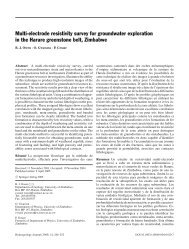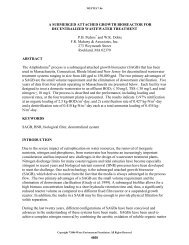Species diversity in the Florida Everglades, USA - Environmental ...
Species diversity in the Florida Everglades, USA - Environmental ...
Species diversity in the Florida Everglades, USA - Environmental ...
Create successful ePaper yourself
Turn your PDF publications into a flip-book with our unique Google optimized e-Paper software.
Aquat. Sci. Vol. 68, 2006 Overview Article 257<br />
Figure 3. South <strong>Florida</strong> today. After more than 100 years of human<br />
“management” <strong>the</strong> hydrology of <strong>the</strong> greater <strong>Everglades</strong> systems is<br />
controlled by a network of canals and control structures that direct<br />
<strong>the</strong> fl ows of water (<strong>in</strong>dicated by arrows) (from McPherson and Halley,<br />
1997).<br />
caus<strong>in</strong>g serious impact on both fl ora and fauna. Water<br />
management has also affected nutrient regimes with <strong>the</strong><br />
release of urban stormwater and nutrient laden runoff<br />
from agricultural areas, <strong>in</strong>creas<strong>in</strong>g nutrient concentrations<br />
<strong>in</strong> <strong>the</strong> once oligotrophic <strong>Everglades</strong> and result<strong>in</strong>g <strong>in</strong><br />
shifts <strong>in</strong> plant community structure. Stober et al. (1996)<br />
listed 6 critical issues fac<strong>in</strong>g <strong>the</strong> <strong>Florida</strong> <strong>Everglades</strong> <strong>in</strong>clud<strong>in</strong>g<br />
eutrophication, mercury contam<strong>in</strong>ation, habitat<br />
alteration and loss, hydropattern modifi cation, and endangered<br />
and exotic species. They suggest that “<strong>the</strong><br />
greatest threat to <strong>the</strong> <strong>Everglades</strong> ecosystem is to assume<br />
<strong>the</strong> issues are <strong>in</strong>dependent” (Stober et al., 1996).<br />
The Comprehensive <strong>Everglades</strong> Restoration Plan. Recogniz<strong>in</strong>g<br />
that <strong>the</strong> <strong>Everglades</strong> was <strong>in</strong> peril, <strong>the</strong> United<br />
States federal government <strong>in</strong> partnership with <strong>the</strong> State of<br />
<strong>Florida</strong> developed a plan to reverse trends, restore <strong>the</strong> viability<br />
of <strong>the</strong> <strong>Everglades</strong>, and assist <strong>the</strong> recovery of several<br />
targeted species (Table 1) . The Comprehensive <strong>Everglades</strong><br />
Restoration Plan (CERP) was implemented <strong>in</strong><br />
1998 for <strong>the</strong> restoration of <strong>the</strong> Greater <strong>Everglades</strong> ecosystem<br />
(<strong>USA</strong>CE & SFWMD, 2005). Described as <strong>the</strong><br />
world’s largest ecosystem restoration project, <strong>the</strong> CERP<br />
<strong>in</strong>cludes restor<strong>in</strong>g <strong>the</strong> natural fl ows of water and historical<br />
hydroperiods and improv<strong>in</strong>g water quality with<strong>in</strong> <strong>the</strong><br />
rema<strong>in</strong><strong>in</strong>g natural areas of <strong>the</strong> <strong>Everglades</strong> system. In addition,<br />
<strong>the</strong> program will address water supply and fl ood<br />
protection needs <strong>in</strong> <strong>the</strong> urban and agricultural regions of<br />
south <strong>Florida</strong> surround<strong>in</strong>g <strong>the</strong> <strong>Everglades</strong> system. The<br />
estimated cost of <strong>the</strong> restoration effort is $7.8 billion;<br />
with annual operation and ma<strong>in</strong>tenance costs, <strong>in</strong>clud<strong>in</strong>g<br />
assessment and monitor<strong>in</strong>g, of about $182 million (US-<br />
CAE and SFWMD, 1999).<br />
Bio<strong>diversity</strong> of different plant and animal groups<br />
While “River of Grass” is an apt description for much of<br />
<strong>the</strong> ecosystem, where vast, predom<strong>in</strong>antly monotypic<br />
stands of sawgrass (Cladium jamaicense) are common,<br />
much of <strong>the</strong> celebrated <strong>diversity</strong> of <strong>the</strong> ecosystem results<br />
from a landscape mosaic that also conta<strong>in</strong>s sloughs, wet<br />
prairies, cypress swamps, mangrove swamps, p<strong>in</strong>elands<br />
and tree islands. The <strong>Everglades</strong> represents a unique <strong>in</strong>terface<br />
between sub-tropical species and those more<br />
characteristic of <strong>the</strong> Caribbean tropics. With a legendary<br />
capacity to support bird and fi sh life, and by provid<strong>in</strong>g a<br />
home for an array of charismatic mega-fauna (e.g. alligators,<br />
<strong>Florida</strong> pan<strong>the</strong>rs, snail kites), <strong>the</strong> biological value of<br />
<strong>the</strong> <strong>Everglades</strong> system is widely cited <strong>in</strong> efforts to protect<br />
and restore this ecosystem.<br />
The <strong>Everglades</strong> is home to numerous species spann<strong>in</strong>g<br />
<strong>the</strong> breadth of its heterogeneous ecosystem-types. <strong>Species</strong><br />
richness has not been reliably quantifi ed for <strong>the</strong> system as<br />
a whole, but with<strong>in</strong> <strong>Everglades</strong> National Park <strong>the</strong>re are<br />
1033 species of plants, 60 species of reptiles, 38 species of<br />
amphibians, 76 species of mammals, 432 species of fi sh,<br />
and 459 species of birds (Table 2; ICE, 2004). The <strong>diversity</strong><br />
of <strong>the</strong> Greater <strong>Everglades</strong> is substantially higher when<br />
one considers <strong>the</strong> cypress (Taxodium spp.) systems <strong>in</strong> Big<br />
Cypress National Preserve, <strong>the</strong> tree island systems of <strong>the</strong><br />
nor<strong>the</strong>rn <strong>Everglades</strong> (<strong>the</strong> Water Conservation Areas – Fig.<br />
3), <strong>the</strong> preserved areas of Lake Okeechobee and <strong>the</strong> Kissimmee<br />
River, and <strong>the</strong> coastal mar<strong>in</strong>e preserves, <strong>in</strong>clud<strong>in</strong>g<br />
<strong>Florida</strong> Bay, Biscayne Bay and <strong>the</strong> <strong>Florida</strong> Keys.<br />
Plants. The fl ora of <strong>the</strong> South <strong>Florida</strong> ecosystem was a<br />
primary factor <strong>in</strong> <strong>the</strong> orig<strong>in</strong>al creation of <strong>Everglades</strong> National<br />
Park (ENP) (Robertson, 1959). Of <strong>the</strong> estimated<br />
1600 species that are found <strong>in</strong> South <strong>Florida</strong>, more than<br />
1000 have been cataloged <strong>in</strong> <strong>Everglades</strong> National Park<br />
alone (Avery and Loope, 1983). Over 150 families are<br />
represented, with Poaceae (124 taxa), Asteraceae (81),<br />
Fabaceae (69), Cyperaceae (53), Euphorbiaceae (45) and<br />
Orchiadeae (42) <strong>the</strong> most diverse; 111 families are represented<br />
by fewer than fi ve taxa. Of <strong>the</strong> fl ora richness <strong>in</strong>
















